

September is a perfect month to visit Japan. The weather generally is excellent; when my
husband and I were there in September 2003 we had warm (70s for the most part), sunny days.
Children were in school, most vacation crowds were over, and there wasn't the rush and crush
of spring cherry-blossom viewing time. Because one of my husband's relatives was working in Mito
City for a while, we had a gracious home base in their apartment, plus their guidance
locally and (albeit new) knowledge generally. The country and its people are amazing; I'm
still not over our trip. I continue to study and research maiko and geisha and kimono customs
and I've created a small Japanese corner in our kitchen which gives me great pleasure. We
were there for 17 days, based in Mito City, but we also went to Nikko,
a lovely mountainous region, Kyoto for four days and then
to Ito and Izu-Kogen on the Izu Peninsula, and also to Tokyo (Asakusa section). We feel the
Japanese were the friendliest people we've encountered on our travels, and that's saying
something, considering how hospitable we've found people in Australia, New Zealand, and
Tanzania. Not only that, but Japan is so lovely, with mountains and rushing rivers, deep
wooded valleys, the ocean, and the picturesque and so historical sections of Kyoto and Tokyo.
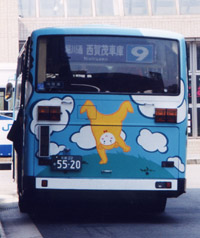
Art is truly a way of life there, from the way food is presented to the way the simplest purchases are wrapped for you (gratis and charmingly) to flowers painted on some buses, the eyelet and lace head cloths on the seatbacks in colorfully hued taxis, and the tiny gardens everywhere. Everywhere! In Kyoto Railroad Station (the famous "bullet trains" are marvelous, fast and clean), I purchase a few souvenirs, as the station contains some charming stores, including one of antique furniture, paintings, and bibelots. My souvenirs are simple, though, and as usual (for I saw lots to buy for family and friends), each piece is wrapped in a lovely print paper, gratis, and then-oh, my! one of the shop girls comes, bows, and presents me with a small wrapped gift. Going by the Japanese gift guide I'd recently read, I bow and reply "arigato gozaimass" (thank you very much), and know that I am to open the gift, after, not in front of them. I am delighted to find a small but charming wooden doll when later I unwrap the gift in the train.
Meals are presented, as many of you know from Japanese restaurants here, in a variety of lovely ceramic and lacquer ware bowls and trays, and they are beautifully garnished. Of course half the time I hadn't a clue what I was eating, but it was delicious! In many restaurants you can choose your courses from either photos on the menus or, more probably, plastic food samples in the windows (you still don't know exactly what you're eating, but who cares?!) Fragrant wet and warm washcloths appear first, and almost always a steamy cup of green tea. I personally found it much easier to sit at a western style table when I could, as my 5'8" body was not used to getting down to cushion height/kneeling. And my size 11 shoes did look out of place placed in a restaurant's vestibule, or on the shelves outside a temple or shrine! I soon became an aficionado of miso soup, sushi, sashimi, sticky rice, sake (cold), and various other dishes. As for green tea ice cream, oh, the dishes and cones of it I enjoyed.
Guess what? Accustomed to NJ and NY prices, Japan is not formidably priced. Not at all! Pick out smaller hotels or ryokans (kind of b 'n bs). And you can purchase bullet train excursion tickets. And bus and subway passes. The subway system is clean; almost all is clean in Japan, it seems. Why, in the complex of shrines which includes the gorgeous Golden Pavilion in Kyoto, I saw bonneted and gloved ladies picking up stray sticks and shrubs! Okay, so we encountered few who could speak English with us(only fair, I can't speak Japanese), and signs were confusing-so one memorizes that one's bus stop has characters in the name of the stop that look like houses or drunken deer, but we managed. And those who could help us, offered to. Kindnesses abound in Japan. The gentleman who exchanged seats on a local train to Tokyo so we could sit together, and then bought us coffee! Offering it with a bow. Oh, yes-the trains employ young women (sometimes men) in darling outfits, who push carts of coffee, tea, sweets, and other items on narrow carts down the aisle. They bow on entering the car, and they bow on leaving. Of course, to save a bit, you can purchase your bento, or lunch tray, in the station ahead.
I can see this will just be a beginning of my story, and perhaps you'll endure with me a second article on specific art venues, for this article can't leave the art of life in Japan without saying a bit more. As an artist, you cannot help noticing that all you've ever seen in Japanese paintings is really there. The wooded mountains do have that puffy atmospheric look, and there are layers of mountains, one in front of another. The clouds do come down and clothe the cliffs in mystery. The people are graceful and there is a certain formality still (although the rush and shrillness of the western world is fast invading and you will find Kyoto and some of the small towns more "Japanesey" than Tokyo).
What I was not prepared for were the many kindnesses we encountered, the real art of life. For example, the thin paper tickets to the shrines and temples were miniature works of art. The flyers and posters given out at museums or shops or shrines or at the railroad station, were rich and colorful. I found a lot of "freebies" as I couldn't resist picking up ads or flyers for I-don't-know-what-because-I-haven't-a-clue-how-to-read-Japanese-characters.
As an artist, or gardener, you will be thrilled by the gardens and flowers all over. The
most crowded of narrow city streets in Kyoto, for example, has mini-gardens, or hanging pots,
or vases and urns with bouquets. Many street lamps have them also, or silk and paper blossoms
hanging down. And in many towns that we saw, gardens and small rice fields are sandwiched in
among apartment complexes! Wow! Needless to say, my senses were reeling. And I haven't even
mentioned the ocean, Aqua World, an amazing complex of aquariums,, or the Sunshine City
Aquarium, on the 10th and 11th floors in Tokyo, an amazing aquarium where a woman in wet
suit plays with and feeds, manta rays and moray eels, and I, who have an obsession with
fish and aquariums, saw fish and exhibits I've never seen before!
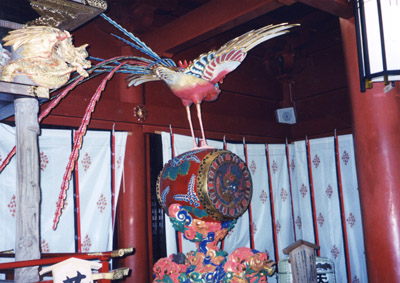
Would you believe that Japan, as well as having hundreds of beautiful shrines and temples, aquariums and zoos, spas and hot springs, wondrous back streets/alleys, gardens galore, and beaches, too, also has three Teddy Bear Museums? I asked, at the most famous one in Izu-Kogun, for the artist bears of Hisa Kato; they had none for sale, although there was an exhibit of her work in the museum. Three hours into my fascinate viewing of this small but elaborate and fanciful museum, a shop girl, in plaid jumper and crisp white blouse, found me on the second floor and, handing me a hard-cover book, she bowed and said, "Gift for you!". It was, literally, the only book on Hisa Kato's work-in its protective plastic cover, their sample book they'd had when they did have her book and bears for sale. I was overwhelmed! It was like the Met handing you the only sample of a book on Van Gogh out-of-stock. I didn't know what to say, and couldn't have said it, in Japanese, at any rate. After thinking it over, I finally sketched a caricature of me in my flowered skirt and frizzy blonde hair, bowing to them, and handed it to the shop girl.
So there you go; I did view museums and wonderful paintings and prints. I'm still trying to absorb what I saw in temples and shrines. I'd love to speak about this another time, but I guess the people seem more important, for this article at any rate. Thanks for reading.
The remarks above described mainly the warmth and friendliness of the Japanese people and the way in which expressing beauty is an everyday occurrence with them for example in the presentation of food, ordinary package wrapping, museum tickets with pictures, etcetera. In the paragraphs below I will talk about some of the more formal ways art and beauty play an enormous part in their lives, by speaking briefly about some of the temples, shrines, and useums my husband and I visited.
One of our early excursions was out into the mountainous country northeast of Mito (where we
were based) and Tokyo, to the lovely small city of Nikko, where the main attraction ( In
addition to gorgeous mountain scenery with trees and mist, waterfalls, and rivers EXACTLY
as you've seen them in Japanese ink paintings) was the Toshogu Shrine. Ieyasu Tokugawa is
the deity venerated in the Toshogu Shrine at Nikko; born in 1542 A.D., which was a time of
great inner turmoil and civil wars in Japan. Ieyasu managed to unify the country, thereby
making a great and lasting contribution for peace and culture to Japan. After Ieyasu died
in 1616, his son Hidetada built this amazing shine for the veneration of his father. This
is really a huge complex of buildings-shrines, temples, a pagoda, a small museum, the sacred
stable, gates, and more, all situated on a hilly incline, and all of it fascinating. After a
whole day of exploration, I still had not taken it all in.
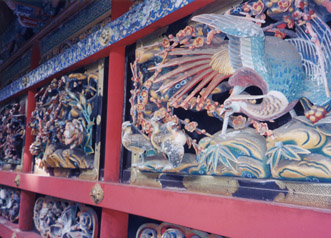
The first things you notice are the complexity of the buildings themselves, the layers upon
layers of ornamentation, and the incredible rich and vibrant colors, as well as all the gilding.
I knew little about the religions in Japan and little about the history and the famous emperors,
so mainly I was seeing things from a purely artist's viewpoint. You may be familiar with Betty
Edwards' book DRAWING ON THE RIGHT SIDE OF THE BRAIN in which she says you can draw (or paint)
better if you don't label something a horse or an ornate gingerbread house; you look and paint
from angles and lines, dark and light, and color. In a similar manner I was looking at form
more than content, and I was totally fascinated. Every square inch of the buildings seem to
be decorated, and each little sculpture or architectural carving seemed a gem. The rich reds
and burnt siennas, the brilliant clear turquoises and intense cobalt blues, the deep sea greens,
the shining golds, on all sorts of figures, flowers, and animals, or creatures, beguile the eye.
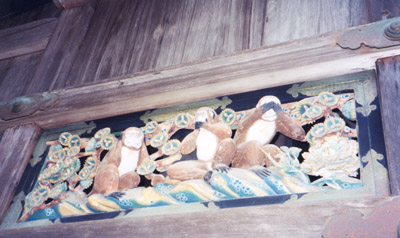
Yes, I did buy the guidebooks (most of them small works of art in themselves) and I learned some of the content, some of the meaning of the animals or birds, etc. and so the shrine complex meant even more to me. For example, on the fašade of the Sacred Stable are wooden carvings, richly colored, and among them are the famous "Three Monkeys", created back in the early 1600s, the famous "See no evil, say no evil, hear no evil monkeys." Wow! So this is where they started! In Japan! Centuries ago. Inside the stable the sacred horse is actually a lovely white stallion given by New Zealand.
I spent quite a lot of time in the inner part of the shrine (as inner as I could go; in almost all shrines and temples there is a real inner sanctum which you can see, but you can't enter. The priests do, but sometimes you REALLY want to look at the artwork close up, but you can't). Carvings, intricate and colorful, hold your attention. I watched and listened to the people, all of them Japanese, as they would clap loudly, once, to tell the deity that they were there and ready to pray or talk to him/her. I walked, in my socks (well aware of my size elevens left in one of the cubicles outside the shrine), on glimmering deep red lacquered floors, and I looked up at a dragon ceiling. Many dragons-a feeling of communality, and yet the more one looks, the more one sees differences in the dragons, or creatures. It was all fascinating, lively, colorful, beautiful. I've not space to speak of the impressive torii (gates), or the walkways, or the fabled five-storied pagoda. I do have to mention that on bushes and trees are left many small pieces of paper, prayers, I think, and also Omikuji, paper fortunes of Omikuji which are often left behind on trees.
I should also mention that one of the two stations in Nikko, the JR station, (busses run from here to many of Nikko's sights) which is the oldest in eastern Japan, is a wooden building, built in 1915, and designed by Frank Lloyd Wright.
Let me mention our trip to Kyoto-19
we spent three nights there. It is said that Kyoto is more
the old Japan, certainly much more so than Tokyo, which is ultra modern (with charming pockets
of "old Japan") and super-busy (with wonderful areas of serenity). I could have spent two
weeks there most happily. A beautiful and fascinating city. The city of real geisha, the
geisha who study for years and keep up the old Japanese culture of music, flower arranging,
the tea ceremony, the art of the kimono, and so much more. Kyoto with its back lanes and
wooden buildings, its tiny gardens and surprising viewpoints. Kyoto with many shrines and
temples, and the Kyoto National Museum. The National Museum also is a complex and I only had
time to enter one of the buildings. Of course I had to dawdle before a humungous circular
pond with varicolored koi and dancing, high-spraying jets of water. Inside, I admired an
exhibit of lacquer ware, as well as one of ancient Japanese ceramic ware and another of
kimonos. The lacquer ware was from the Heian Period (10th century) to the late Edo and
Meiji Periods (19th century). I hadn't even known that lacquer is made from the sap of
lacquer trees, which grow only in Japan, Korea, China, and some S.E. Asian countries! Lacquer
sap has strong adhesive properties; when dry, it becomes solid and the gloss of the surface
stays permanently. Originally transparent, lacquer sap turns red, black, yellow, and green
through chemical processing.
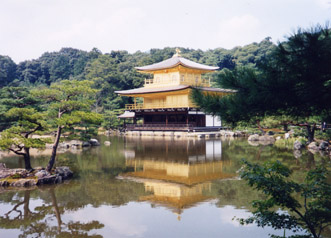
In Kyoto also is Kinkaku-ji, the Golden Pavilion. Again, there is a complex of handsome
buildings of different sizes, in a garden-like park, with the headliner, so to speak,
the Golden Pavilion, its glowing color and shape reflected perfectly in the pond in front
of it. Of course the pond is a work of art, with small islands of greenery and iris scattered
about. Kinkaku-ji was built as a villa retreat at the end of the 14th century by the third
Ashikaga Shogun. The gold leaf on the walls is so thick the pavilion glows even in cloudy
weather. I remember the Golden Pavilion especially well because of the trio of middle school
girls, in neat navy blue uniforms and knee socks, who tried to practice their English on me
and wanted to be photographed with me (we saw very, very, very few American tourists the
whole trip, and only a couple of blondes).
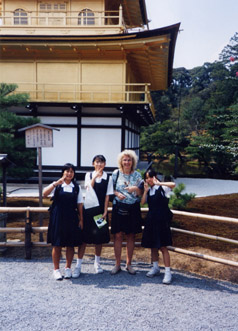
Kyoto is also home to Nijo Castle-a complex created by the Shogun Ieyasu Tokugawa (yes, the same as was celebrated in Nikko). Only here was where this great Shogun lived and this is where you may find ornate interiors and the famous "nightingale floors". These floors, throughout the palaces' interiors, were cleverly constructed of polished wood in many pieces to make squeaking birdlike (nightingale) sounds which would warn the Shogun and his guards that someone was intruding. The floors did make very weird birdlike sounds. Amazing! Even when I looked at construction diagrams it was still amazing (but then, cameras still awe me). The largest paintings of the Kano School, originally from a low-ranking samurai family, decorate the walls of the Nijo Castle. Done in the 16th century, the several motifs include life-size tigers and panthers crouching among bamboo groves, pine trees, wild geese and herons, and frolicking peacocks. The backgrounds of these paintings are usually a sort of matte-finished gold paint, and the rooms are made luminous by the glowing walls. High stone walls surround the palaces' complex, and a moat, complete with graceful swans. Kyoto is home to many shrines, temples, palaces, pagodas, and such, so let's not forget Sanjusangendo, also known as the Rengeo-in Temple. Sanjusangendo is dedicated to Kannon, the Buddhist goddess of mercy. The gilded statue of the thousand-armed Kannon, carved by Tankei in 1254 is surrounded by 1,000 smaller statures of Kannon the work of 70 sculptors. Now this was fascinating, as at first (and even second) glance all the statues seemed remarkably alike-your stereotypical "Buddhist" face. Not so! The more I stared, the more minute differences I could see in the figures, from the curve of their lips to the shape of the eyeballs, to what they were holding in their different arms. And it was in Sanjusangendo that I purchased a journal which was inscribed with different symbols, in deep black ink by a monk or a priest, while I waited. What a thrill to watch him hold the bamboo brush, perpendicular to the pages (which fold out, like a screen), and paint-write, while I waited. There were also nightingale floors in parts of Sanjusangendo!
Tokyo is also home to many temples and shrines, but Tokyo is huge, and has several subway lines, and so many people, buildings, stores, a huge zoo in the middle of the city, and a truly great aquarium on the 10th and 11th floors of the Sunshine City section (how they constructed this, with all the weight involved, up so high in a place known for earthquakes is very interesting). My husband and I spent much of our time in the Asakusa section, and so it was reminiscent of New York City in that you can have a "neighborhood" which becomes familiar to you, in the midst of millions of people and thousands of buildings. And so the Asakusa Kannon, the popular name for the Senso-ji Temple, was our focus, since we stayed in Asakusa and wandered there and ate our dinners in that section. This is Tokyo's most sacred and spectacular temple complex. The first shrine was built there in 645! The main hall houses the original Kannon (Buddhist goddess of mercy) and worshipers come to pay their respect by first clapping to get her attention and then praying, lighting candles, for which they've paid in coins (much like in large Catholic churches). In fact, although the colors, so very bright and glowing, and carvings, and people looked different, I was actually reminded of St. Patrick's Cathedral in New York City, and Notre Dame, in Paris. However, at Asakusa Kannon, there are a lot of other buildings, and an incense burner (looking like a large well), and a garden, several shrines to other deities, and a sort of narrow river with Koi, as well as a five-story pagoda. The incense burner is one of the temple's focal points and is constantly surrounded by people wafting the smoke over them to keep them healthy. I didn't find out the reason until later, but I wafted a lot of smoke over me just to smell it and see if I could feel it (no, you can't feel smoke, even strong incense smoke, but I was curious).
There is much more to say, but I've gone on too long already. You might want to visit the Tokyo National Museum which has several rooms of art which condenses much of the history of Japanese art. I viewed other small museums, like the Ibaraki Museum of Modern Art (Mito City) where I saw rooms full of oil paintings in the style of the French Impressionists, Post-Impressionists, and Expressionists. This was in sharp contrast to those paintings by Van Gogh and Degas and even Gauguin who were influenced by Japanese woodblock prints. There were several fascinating exhibits of kimonos, and ceramics. Of course all this is made more pleasant because of the friendly Japanese people, the awesome scenery, and good food. What a wonderful country to see! I really need to read and learn more and go back. You'd love it!
Your comments/questions are welcome. Please send them to
Copyright © 1998-2014, Diana Patton, All Rights Reserved
All photos, images, text, design elements and other content of this website are the exclusive property of Diana Wilkoc Patton, © 1998-2014, and are not to be used without her express written permission, under penalty of applicable copyright laws
(02/05/14)